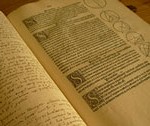What makes a book rare or special? How do we, as librarians and archivists, create access to our often siloed rare book collections? These are some of the questions I had a chance to ponder while attending Rare Book School at the Alderman Library on the campus of the University of Virginia this summer.
Thanks to a Nyenhuis grant from Hope College, I had the opportunity to attend a rare book cataloging class, led by the inimitable Deborah J. Leslie of the Folger Shakespeare Library. This five day course was packed full of standards, principles, exercises, and excursions. I won’t bore you with the details, but let’s just say, it was a cataloger’s dream.
You may be wondering why we catalogers choose a more detailed level of metadata for our rare materials. When thinking about the content of a book, there really isn’t much difference between the description of something from 1600 to now. Most of the access points should be the same. For instance, we would always include an author, a title, and subject headings.
The differences come largely from the physical copy in hand. Often times, a book printed before the 19th century will be unique in some way from copy to copy. There may be differences in the publisher’s advertisements, printing irregularities, bindings, size, illustrative content, editions, issue, impression, or state. We need to know whether the book comes from the machine-press or the hand-press period. What kinds of notes are in the margins? The list of questions could go on.

So, why would a researcher care about these minor, or major, differences? Sometimes, the way books are treated over the years can tell us a lot about the people who used them. Did the owner have the book rebound? Are pages torn or missing? This could also indicate errors from a printer. In a new edition, were there significant changes to the text, and if so, why? How many copies and re-issues are printed tells us a lot about the time period and what people valued. The actual, physical book-in-hand tells us a lot about our own history. All of this is important to researchers. As a cataloger, these are among the types of things to think about when trying to create access. The metadata I choose to add, or choose not to, may determine whether a researcher successfully finds the material for which they are searching. The extra details about our rare books may help them in their research quest, so it is extremely important that I add the right details in the right way.
We have a significant collection of materials in our rare book collection at Hope College, thanks to many generous gifts. The Thomas E. and Jennie W. Welmers Rare Book Reading Room is located on the lower level of Van Wylen Library. My job is to make sure that more than just the library staff know what we have. Thanks to the rare book cataloging class, I can do this with confidence.
As the rare book collection in Van Wylen becomes more accessible in our catalog, I urge you to take advantage of it. Ask for a tour. Ask to see the books, hold them, and learn about them. Use them – that’s what they’re here for!


